USDOT Thriving Communities Program: Lima, OH
15 minutes Date Launched/Enacted: May 20, 2025 Date Published: May 20, 2025
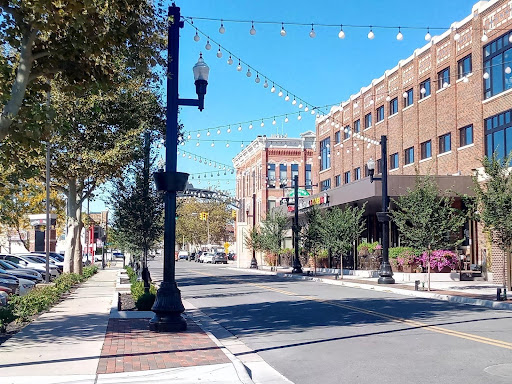
About the Thriving Communities Program (TCP)
The Thriving Communities Program (TCP) funds tailored technical assistance to under-resourced and disadvantaged communities, helping them better access historic infrastructure investments and deliver transformative projects. The USDOT FY 2022 Thriving Communities Program supports 64 communities across the country with access to a team of capacity builders to develop innovative community engagement methods, identify funding opportunities, and grow long-term capacity to develop and deliver transportation projects that strengthen communities.
TCP Complete Neighborhoods Community of Practice
TCP Communities are grouped into three Communities of Practice: Main Streets, Networked Communities, and Complete Neighborhoods. The 15 communities included under the Complete Neighborhoods Community of Practice are:
| Atlantic Beach, SC | Isabela, PR | Santa Cruz, CA |
| Billings, MT | Lansing, MI | St. Louis County, MO |
| Decatur, IL | Lima, OH | Suffolk, NY |
| East Orange, NJ | Providence, RI | Sumter, SC |
| Indianapolis, IN | Roanoke, VA | Waukegan, IL |
The US Department of Transportation (USDOT) selected a capacity building team led by RMI, including: the American Council for Energy-Efficient Economy (ACEEE), Equitable Cities, Nelson\Nygaard, and the Shared-Use Mobility Center (SUMC), to provide technical assistance to these 15 communities.

A Snapshot of Lima, Ohio
The City of Lima, Ohio is located in northwest Ohio and serves as the county seat of Allen County. Lima is roughly 60 miles southeast from the closest major city, Fort Wayne, Indiana, and has a total area of almost 14 square miles. The city’s population (35,579 as of the 2020 U.S. Census) peaked in the 1970s and is projected to continue declining over the coming decades. Outside of the city limits, the larger Allen County region, served by the Lima-Allen County Regional Planning Commission as the local Metropolitan Planning Organization (MPO), counted some 102,206 residents as of the 2020 Census.
Lima’s per capita median income of $19,098 is significantly lower than the state ($34,526) and national ($37,638) medians. Lima faces challenges familiar to many smaller Rust Belt communities, struggling to retain population in the wake of the steady decline of the manufacturing and industrial sectors as cornerstones of the local economy. The city’s population has dropped by an estimated 34% since 1970, with Downtown Lima in particular experiencing disinvestment as retail establishments and residents have relocated to the suburbs. Portions of the downtown are recognized as Opportunity Zones (federally designated economically distressed areas), and based on data from USDOT’s Equitable Transportation Community Explorer, the city is considered disadvantaged in terms of transportation cost burden, poverty rate, and several health factors, including air quality. Economic revitalization efforts that will retain and attract new families to the city are a high priority for local leadership.
Recent planning efforts, such as the city’s 2040 Comprehensive Plan, call for renewed investment in Downtown Lima to become more of an economic engine for the broader Allen County region. This revitalization will require coordinated, strategic transportation infrastructure investments in line with the community’s priorities and vision. In applying to participate in TCP, the City of Lima noted an interest in building local capacity for improving public involvement in the transportation planning process, leveraging federal discretionary grant programs, and using data-driven methods to plan for streetscape improvements that enhance the experience of public transit riders.
Key Initiatives
In Lima, local leaders are helping support downtown revitalization efforts through several strategic transportation improvements. The TCP workplan for Lima focused on the following four core initiatives:
- Improving community engagement in the transportation planning process to ensure that community input guides decisions
- Supporting coordination between the City, MPO, and the public on Transportation Improvement Program (TIP) project development and prioritization
- Improving safety, access, and equity by making upgrades to transit stops and other pedestrian infrastructure
- Supporting applications for federal funding
Four direct funding contracts supported through TCP helped advance this work plan, along with ongoing guidance and direct technical assistance products that ACEEE provided for the team as the lead capacity builder.
Key Partners
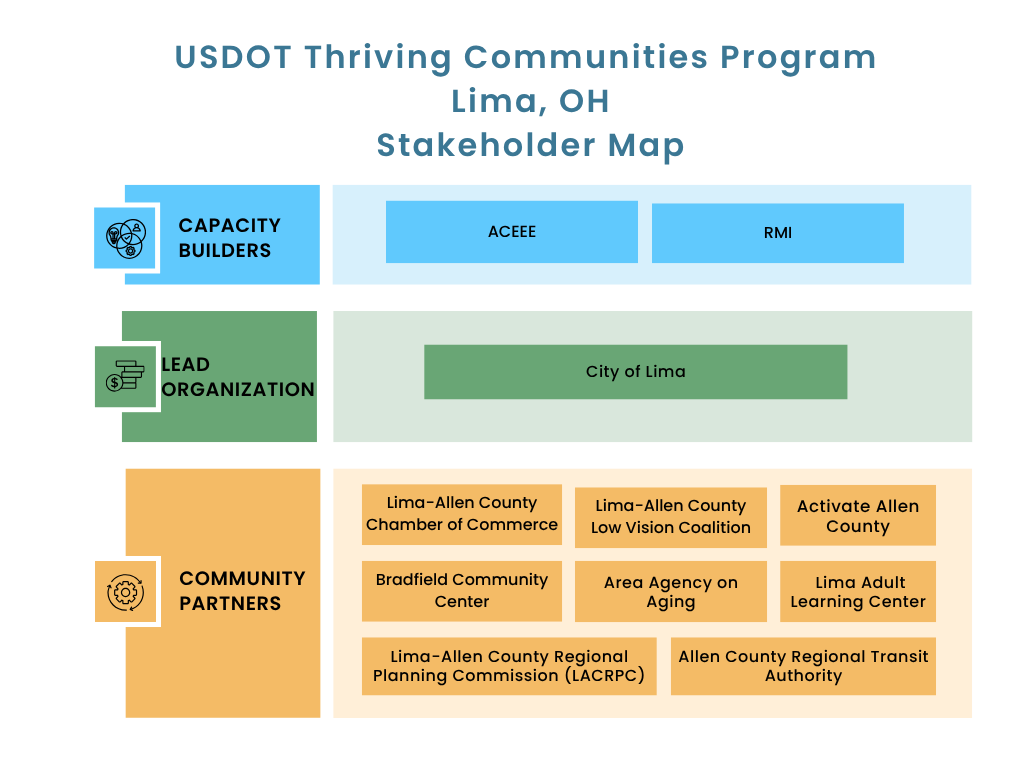
Stakeholder Map. Credit: SUMC
Throughout the course of TCP, representatives from several local agencies remained involved in biweekly meetings to advance the community’s work plan. As the local TCP lead, the City of Lima Public Works Division of Engineering helped steer the work plan and highlight important priorities for the community throughout the program. With leadership from the City Engineer, the Public Works Division has been able to take advantage of TCP to build capacity in public engagement, management of federal funds, and more.
In another city government department, participation from Lima’s public information office has helped ensure that TCP efforts are integrated into other ongoing city initiatives and effectively communicated to Lima residents.
Outside of the City of Lima government staff, representatives from the local MPO, the Lima-Allen County Regional Planning Commission (LACRPC), were also key TCP partners who both helped shape the program’s efforts in Lima and who benefited directly from tailored technical assistance through the program. Similarly, the local public transit agency, the Allen County Regional Transit Authority, helped inform the workplan initiatives focused on improving pedestrian access at bus stops by sharing local data on route ridership, high priority service areas, and other local needs related to public transit.
Outside of these three government agencies, the TCP effort in Lima was also supported through the involvement of stakeholders from several community-based organizations who participated in the City of Lima Community Ambassador Pilot Program. These include the Lima-Allen County Chamber of Commerce, Activate Allen County, the Lima-Allen County Low Vision Coalition, the Bradfield Community Center, the Area Agency on Aging, and the Lima Adult Learning Center.
Activities through the Thriving Communities Program
In support of the four key initiatives outlined above, TCP activities in Lima included both discrete studies as well as ongoing capacity building and process improvement in order to help the core team of government partners advance their goals for the program.
Improving community engagement in the transportation planning process to ensure that community input guides decisions
Community engagement was a key focus area of Lima’s TCP work plan, as the city looked to implement best practices for increasing public involvement in the transportation planning process with limited resources. ACEEE, the Capacity Building lead, worked with the City of Lima to develop, launch, and maintain a brand-new forum for ongoing engagement, called the City of Lima Community Ambassador Pilot Program (“ambassador program”).
The ambassador program brought together trusted leaders from a cross-section of the community, including staff and board members from various non-profit, business, and neighborhood groups, to inform the city’s upcoming Safe Streets for All (SS4A) planning process by taking a proactive and community-led approach to identifying safety needs and priorities across Lima’s public streets. Beyond the SS4A process, the ambassador program creates a framework for an ongoing feedback loop between city staff and community members on transportation needs, priorities, and upcoming projects.
The ambassador program met in-person as well as virtually across Fall 2024 and Spring 2025, carrying out five total meetings during TCP. Local partners also deployed strategies for interactive engagement with the ambassadors between regular meetings.
To support community engagement initiatives tied to transportation safety planning, capacity builders prepared a customized Walk Audit Toolkit for Lima. Walk audits are events where community residents and other local stakeholders gather to walk or observe conditions on a specific roadway in the community to collect information— observations, concerns, ideas, and other notes—about the location to inform future projects. The customized toolkit, which included three different templates for observation forms to support walk audits at various types of locations, will support the City and MPO in engagement efforts for a wide variety of transportation projects moving forward. In March 2025, city and MPO staff convened community ambassadors for a walk audit using these materials to assess conditions on Union Street in Downtown Lima ahead of an upcoming project on that corridor.
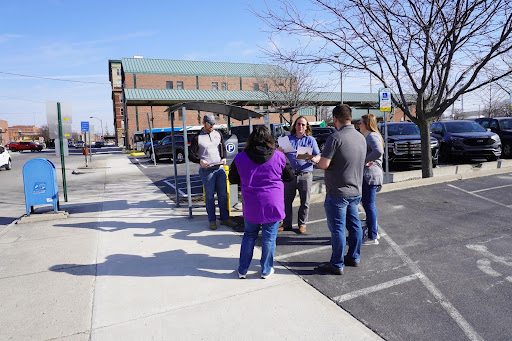
City of Lima staff, MPO staff and community ambassadors conduct a walk audit along Union Street. Credit: ACEEE
Outside of the ambassador program, the community also worked with the program lead at the Lima Adult Learning Center (LALC) to “meet people where they’re at” with public engagement opportunities. The City Engineer attended several in-person classes at the learning center in April and May 2025 to help conduct a survey on transportation safety priorities with students, and the program lead distributed this survey to around 90 students across 24 different adult-learning classes during Spring 2025. Like the focus of the walk audit program, the survey responses will help inform the city’s upcoming SS4A planning process that is tentatively expected to launch at the end of 2025.
Supporting coordination between the City, MPO, and the public on Transportation Improvement Program (TIP) project development and prioritization
The Capacity Building team also supported Lima in helping inform the development of project lists for the Transportation Improvement Program (TIP) managed by Lima-Allen County Regional Planning Commission (LACRPC). The October 2024 meeting of the Community Ambassador Pilot Program provided ambassadors with education on the MPO process and the TIP as a planning tool.
This conversation helped ensure that local community leaders understand the role of the TIP and are able to better navigate public processes to share their feedback on transportation needs and priorities for federal funding. Community leaders walked away with an understanding of the scale of projects that are typically funded with federal funds in the TIP as well as the limitations of federal funds for projects on local roads.
The Capacity Building team also prepared a memo for the City of Lima and LACRPC summarizing case studies from other MPOs and important considerations around the evaluation and prioritization of projects for the TIP, as well as a memo on best practices in incorporating public input into the project development process.
Finally, a direct funding contract through TCP provided resources for staff from the city and MPO to access training materials from the Association of Metropolitan Planning Organizations (AMPO) MPO Institute program. The MPO Institute training courses provide MPO staff and their key partners with in-depth training on the MPO process, federal transportation funding, and other topics that directly relate to a region’s ability to successfully identify, secure, program, and implement federal funds. AMPO staff also traveled to Lima in May 2025 to provide a tailored, daylong workshop for city and MPO staff covering these important topics. This helps ensure that local capacity for accessing federal funds will endure beyond the duration of TCP, and that the two teams are implementing best practices for programming TIP projects.
Improving safety, access, and equity by making upgrades to transit stops and other pedestrian infrastructure
Through TCP, local partners in Lima also aimed to obtain support on collecting and analyzing data to inform which bus stops the City of Lima should focus on when installing adjacent concrete boarding/alighting areas or other accessibility upgrades. This analysis would support the City of Lima and the Regional Transit Authority (RTA) in collaborative efforts to improve safety, access, and equity across the community by enhancing the ridership experience for transit users.
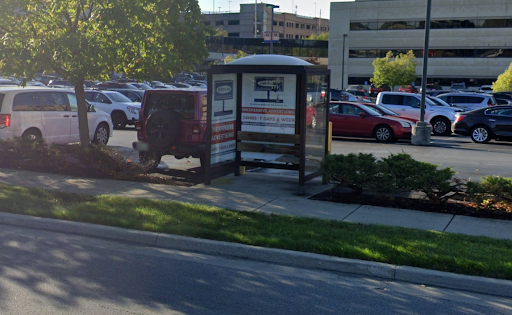
A bus shelter outside of St. Rita’s Medical Center. The lack of a hard surface between the sidewalk and the street means that riders in wheelchairs may have difficulty boarding or departing from the bus. Credit: Google Street View
To support this, the Capacity Builder team prepared a data-driven prioritization methodology for local partners to use moving forward. Using demographic data from the American Community Survey, local transit ridership data, and local data on existing pedestrian facilities as well as high-priority community destinations, the Capacity Builder team prepared a geospatial analysis for Lima that prioritizes locations for future upgrades based on a layering of these data sources. This methodology will be something that the city can build upon moving forward depending on specific needs for other related planning processes, making it a valuable contribution for Lima.
A direct funding contract supported through TCP paid Guide Studio, an Ohio-based consulting firm specializing in wayfinding materials, to create a new bus stop signage design for the RTA network. This effort will make the system more accessible and more legible for users, a key aspect of a successful public transit network.
Supporting applications for federal funding
The Capacity Building team also supported the City of Lima’s 2024 application for the Safe Streets for All (SS4A) Planning and Demonstration Grant to develop an Action Plan, which is intended to prevent roadway deaths and serious injuries, by reviewing the draft application prior to submission. The Capacity Building team reviewed and provided feedback for the 2024 Notice of Funding Opportunity criteria to ensure that Lima’s application sufficiently met the necessary requirements. The Capacity Building team also reviewed and provided feedback for the Planning and Demonstration Grant checklist provided by USDOT against Lima’s submission documents to ensure that all the necessary forms were included in the application packet. Lima was awarded the SS4A grant they applied for; the city’s first discretionary federal grant.
On Union Street, a main downtown corridor, a high-priority planning project in Lima aims to convert the existing one-way, two-lane street into a one-lane facility with reverse-angle parking, a bike lane, and curb extensions. This retrofit will help make Union Street more accessible for all modes of transportation, improving access to the downtown core. Through TCP, the Capacity Building team directly assisted the City of Lima in developing and applying for the FY2025 RAISE program (renamed to BUILD in January 2025) – a federal competitive grant program that funds major transportation projects.
Cohort-wide webinars on successful strategies for accessing federal discretionary funding, as well as individualized grant narrative review that the Capacity Building team provided, helped Lima submit an application for the program. While these awards are yet to be announced as of the conclusion of TCP, the Capacity Building team is hopeful that Lima’s application will be successful, allowing for a needed infusion of federal funds to advance the city’s downtown revitalization efforts.
Beyond the scope of this specific application and project, the City of Lima Division of Engineering and the local MPO, LACRPC, are both newly equipped to take advantage of future federal funding opportunities thanks to off-the-shelf and personalized support from AMPO.
Other initiatives
Finally, a direct funding contract through TCP engaged local transportation engineering firm EMH&T to develop detailed renderings of the proposed vision for Union Street. These are intended to support future communications and/or future applications for new funding for the project.
October 2024 Site Visit
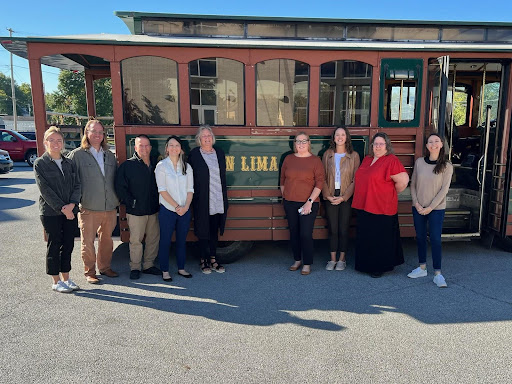
Christi Nakajima and Caroline Daigle with ACEEE, as well as Jackie Lombardi with RMI, joined City of Lima, LACRPC, and Allen County Regional Transit Authority staff on a trolley tour of the city. Credit: ACEEE
In early October, the Capacity Builder team conducted a site visit to Lima, Ohio to facilitate a kickoff meeting for the ambassador program, which involved sharing information about the proposed program, soliciting feedback from attendees, and gauging interest among attendees in serving as ambassadors. The community-based organizations that joined the meeting included:
- Bradfield Community Association
- Area Agency on Aging
- Lima/Allen County Chamber of Commerce
- Lima Adult Learning Center
- Lima-Allen County Neighborhoods in Partnership
- Lima Community Improvement Corporation
On the second day, the Capacity Builder team conducted a walking/trolley tour of the community to get a firsthand look at various project sites and high-crash corridors. The site visit concluded with a meeting with LACRPC to discuss the potential for using TCP funds to provide staff with access to MPO Institute courses and to fund a personalized training from AMPO.
Related Resources
Capacity building efforts through the Thriving Communities Program are continuing until May 2025. The Capacity Builder team will conduct more technical assistance activities and will update this case study as the program progresses.